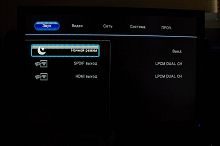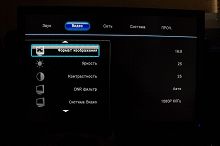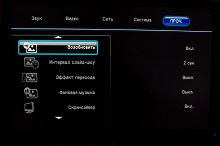Not popcorn single
In September this year, BBK released four new online media players so that life would not seem like honey to popcorn. The names are no longer so memorable, however, it is easy to understand who is following whom - BBK MP050S , MP060S , MP061S and MP070S .

Not so long ago, these devices began to appear on store shelves, so I decided to acquaint you with what the company released this time.
As in glossy magazines, it would be possible to tighten a long song about the fact that the Internet is entering our life more and more and how great it is to watch the right movie with your friends without a computer ... but I hope that such a class of devices like HD media players do not need to be introduced therefore, I propose to proceed immediately to the body. I decided to take the most "adult" model, namely, BBK MP070S .
')
Embedded HDD Type : 3.5 "SATA HDD
Video Output : Composite, Component, HDMI 1.3
Resolution : 480p, 576p, 720p, 1080i / p (24/50 / 60Hz)
Audio output : Stereo RCA, Coaxial, Optical SPDIF
Connectors : 2xUSB, miniUSB, eSATA
Card reader : SD, MMC, MS
Network : RJ-45 Ethernet; 802.11n optional
Services : BitTorrent Client
Decoders : DTS, AC3
Supported codecs
Video : DivX, XVID SD / HD, MPEG-1/2/4 / 4.2, WMV9 (MP @ HL), H.264, VC-1, AVC (HD)
Audio : AC3 (Dolby Digital), DTS, WMA, WMA Pro, AAC, MP1, MP2, LPCM
Supported Formats
Video : MPEG-1/2/4, MPEG-1/2 PS (M2P, MPG), MPEG-2, VOB, AVI, ASF, WMV, MKV (Matroska), MOV (H.264), MP4
Audio : AAC, M4A, MPEG audio (MP1, MP2, MPA), WAV, WMA
Subtitles : SRT, SMI, SUB, SSA
Photo : JPEG HD, JPEG, BMP, PNG
Other : ISO, IFO
Dimensions : 162x210x51.5mm
Weight : 0.88kg
The box is quite small and light - the lion's share of the space inside is occupied by a porous material, in the thick of which the media player was hidden. Additionally, the device was wrapped in an air bubble film (pi-pi-pi)
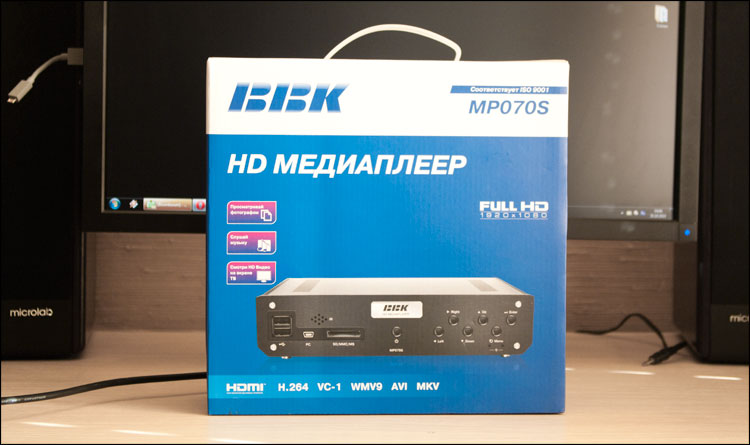
So, included:
- HD-media player BBK MP070S
- Operation manual + warranty card
- Wires for connecting an external SATA disk
- Hex L-key
- Wire 3xRCA-3xRCA
- Audiovideo cable
- Network adapter
- miniCD disk
- 4 screws
- Remote controller
Immediately we can note the absence of HDMI-wires in the kit, which is very strange - this is the second most important (after power) cable to the device. And in the previous models of media players from BBK (like the best-selling Popcorn NP101S), the wire was attached. There is no patchcord, but at least it's easier to get it. The instruction is black-and-white and fairly detailed (30 pages), the site has an electronic version of the manual.
The media player is compact enough - a little more than ASUS O! Play , but significantly less than previous models, much less such combines as Dune Base . Low weight, which means that the disk has yet to be put - perhaps it will fit inside it.
The body is entirely made of ferrous metal, but its texture in different places is different. For example, the top cover is semi-gloss, the front side has a fine polishing texture, and the side “edges” are pleasantly rough. Why such a platter is not clear, but on the whole it looks very solid - if it were not for the BBK sign on the front side, then no one would have guessed anything)

On the front side, there are many unusual things - a handful of buttons duplicated from the console and uncovered connectors (2xUSB, miniUSB and a card reader for SD / MMC / MS) create the basic “hype” - on the one hand, this “scatter” really scares ... but with on the other hand, this is practical, since the user of devices will not have to go anywhere to connect, and it will be possible to control the process without a remote control.

On the reverse side is another “assorted” - a whole scattering of various connectors. Ethernet, HDMI (1.3), component and composite video outputs, stereo output, digital optical and coaxial audio output ... There is even eSATA for connecting an external drive - in general, a good arsenal! Instead of the usual power cord (C13), you will have to use a network adapter, since the device cannot be more than 12V. Power consumption - less than 16W.
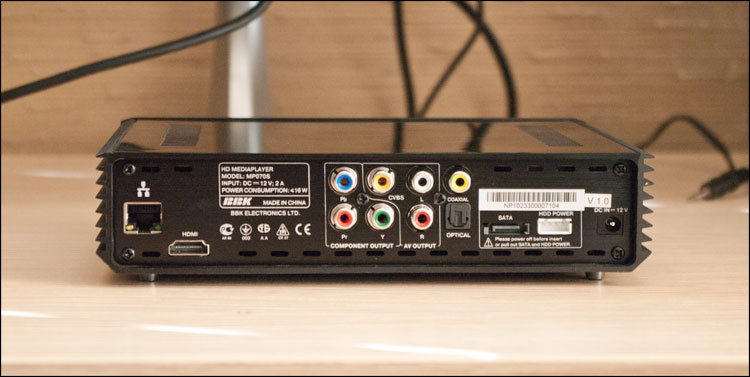
There is nothing on the sides except the "ribs" - at first I thought that the system was completely passively cooled, but several vents destroyed all my hopes)
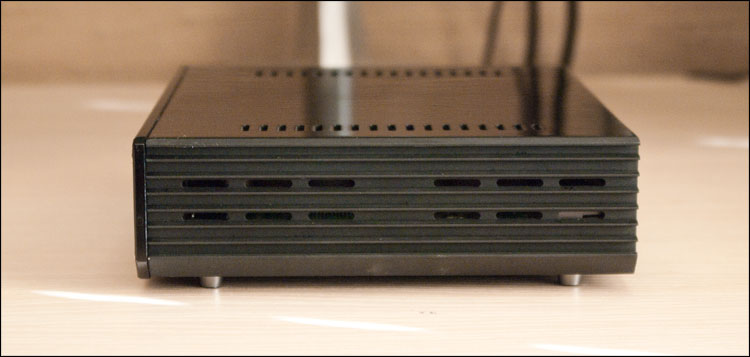
On the bottom side there are 4 stylish metal legs with rubber inserts.

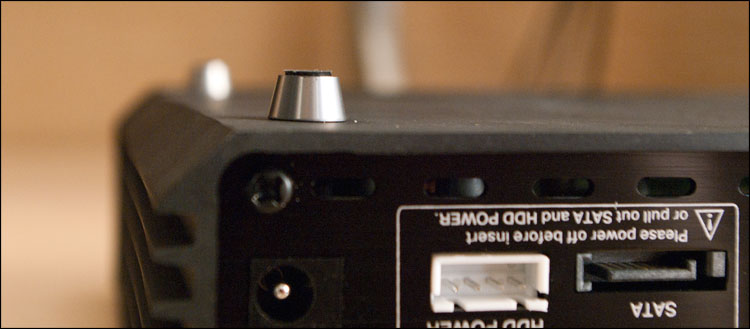
After carefully examining the case (in search of warranty seals and screws to disassemble the case), I came to the conclusion that no covers are simply removed — you have to unwind the case to install a disk; However, the hex key in the kit is not just put. This is all written in the instructions ... but inquisitive minds do not read them;)

I was hoping that everything would be limited to 4 cogs on the front side, but as it turned out, they hold only the front part of the case - a neat all-metal plate with holes. Literally in an instant, I was crawling under the table in search of decorative nozzles that had flown down from all the buttons - they are not fixed at all, so be careful when disassembling (or rather drop a drop of superglue on each button).


The board did not pull out, although most of it was already visible. I had to unscrew 2 more screws on the back side - only then was happiness. Yeah, the path is not easy - in most cases you have to unscrew no more than 2-4 cogs ... or even insert the disc into the retractable slide.
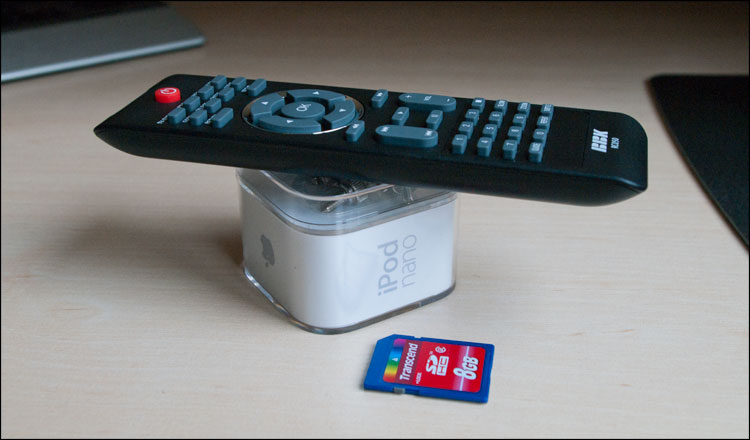
Very, very liked the remote! From which side you do not look at it, it is rather small and light, but all this is not at the expense of the convenience of holding in your hand. Slightly rough plastic (quality) conveniently located buttons - Power at the very top will definitely be in the dark; The “circle” for moving around the menu is clearly highlighted and can be used without moving the remote in your hand; track control buttons, volume buttons - you will not confuse them with anything either. Everything is great - the only drawback is that there is no backlight - in the dark in the "small" buttons will not understand (well, or have to memorize everything). Food - one lithium CR2025 battery on 3B (140 mAh).
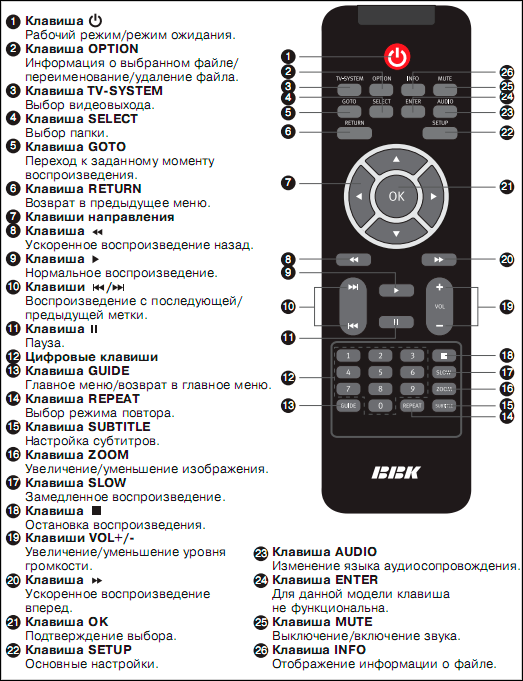
If you look at the top, most of the printed circuit board takes up space for the hard disk - it is supposed to join it to the corresponding connector and tighten the bottom 4 screws from the kit. At this stage there is an unpleasant trifle - the complete screws have a very large cap, with which they touch a part of the board connectors; The easiest way is to use "your" screws, but if someone does not have them, you will have to search. Or work with a file;)

Next to the disc area is a sticker with hieroglyphs, where only “1Tb” is understandable - apparently, this is a restriction on the volume of 1Tb; it is also confirmed in the manual - as long as the manufacturer promises correct work only with disks up to 1TB (as well as with cards up to 4GB and flash drives up to 16GB).

I only had disks for 500 and 1000GB - everything worked without problems. Although ... I tried the existing 32GB flash drive for the sake of interest - the player fell into a stupor until the flash drive was removed. All tests were conducted on a 500-gigabyte Seagate ST3500830SCE DB35.3 .

There is nothing more interesting on this side of the board - soldered buttons, diodes and connectors. Much "meat" on the reverse side. Ten two konderov, NAND- shemku Hynix HY27UF082G2B (controller AU6986 ) and a kind of indefatigable Mega 1008NE MPTU1G16DG-AC .
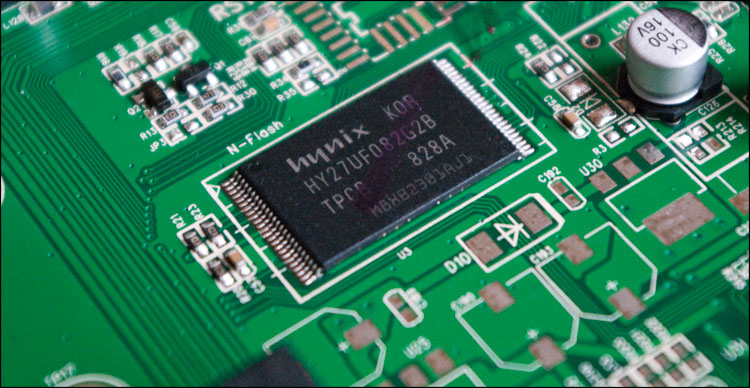

There are two more “prepared” places where nothing is unsoldered - perhaps something will appear in the next versions of the device, if they are on the same board.

The most "tasty" ( Realtek RTD1073DD ) is under a small cooler - I did not take it off, as it seems to be on hot melt, which I simply do not have.

At first, the device worked on the table (or rather, on the packing “foam”) in a disassembled form - the main thing is that the cooler does not cling to anything. It is impossible without it - in idle mode, even on the reverse side of the board it becomes very hot. In this situation, there is a small hum (“cooler + hard disk” at a distance of 50 cm from the ears), but if you put everything in the case and sit a couple of meters away from the TV, you can ignore the noise.
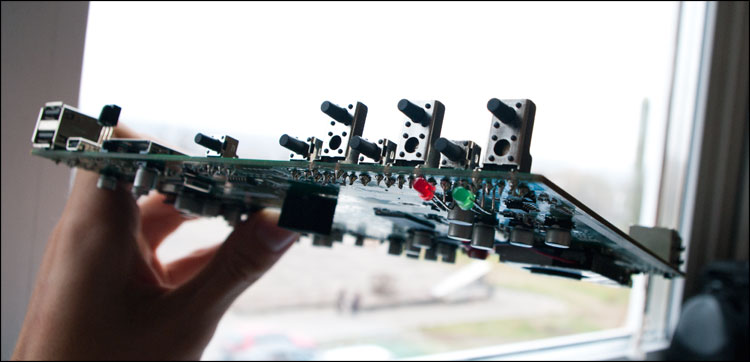
The manual says that the remote control must be carefully aimed at the IR receiver, but my signals were received even at an angle of 90 degrees. After pressing the "red button", the device turns on and comes on full alert for a modest 15 seconds.
First, there is a primary configuration - language (9 languages available, including Russian) menu, date and time, task of wired network parameters (I trusted DHCP, although everything can be driven in manually; I liked how the fields for entering IPs look like). Then follows the offer to format the installed disk.
By the way, the most primitive interface was to be observed further, to which I was somewhat surprised. Why did the company develop the “sensational” mediabar shell if it is not here? But I was hoping to see) Moreover, even in previous models of popcorn, the interface was much more advanced and functional. Here ... something completely incomprehensible from the past. But, we have to admit, IT does not slow down at all and, in principle, performs all the tasks well;)
So, the main screen consists of only 3 items - “ View ”, “ Settings ” and “ Copy ”.

Due to the fact that in each of the paragraphs there is not so much of everything, I will delve a little into intimate details. I really wanted to make beautiful screenshots, but even with the PIP mode via the component connection, the image could not be captured (and there was no capture card) - so everything was taken with a tripod.
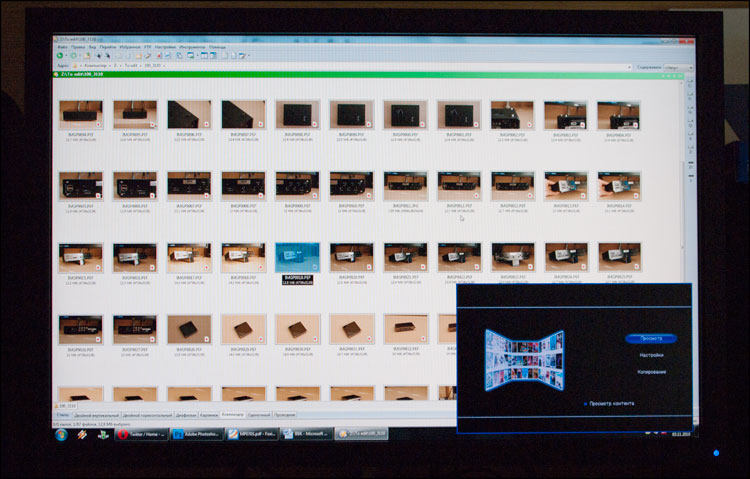
 View
View
At the very top of this window there are 4 tabs of “media filters” - “movies”, “photos”, “music” and “all”; This is not a new approach, but as practice shows, it is very convenient.

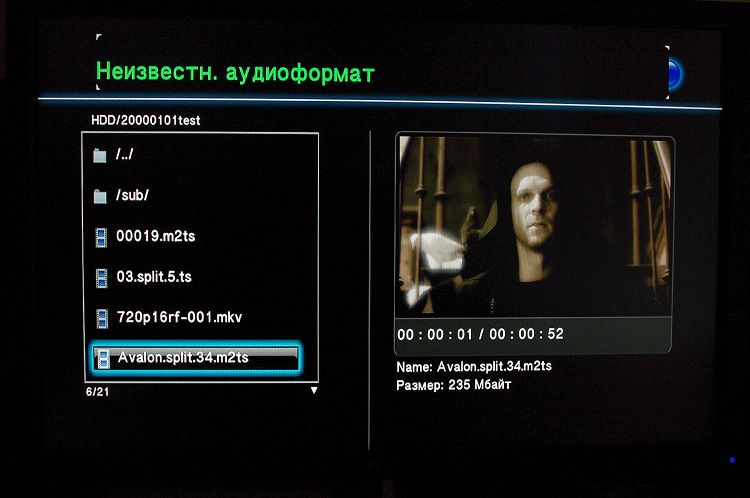
Below is selected the data source - USB-drive, HDD, DVD, NET or memory card. It is strange that all this is present, although some of the carriers are simply not in the system.
Moving through folders is fast, as well as flipping through the file list. Each file to the right of the name displays information about it, and in the case of media data, the contents are also shown in the preview window. It is inconvenient that there is no scrollbar in the file selection window.
If you try to create a new folder somewhere, the on-screen keyboard will appear on the screen; you will have to print on it if you want to log in through the player to any computer on the network.
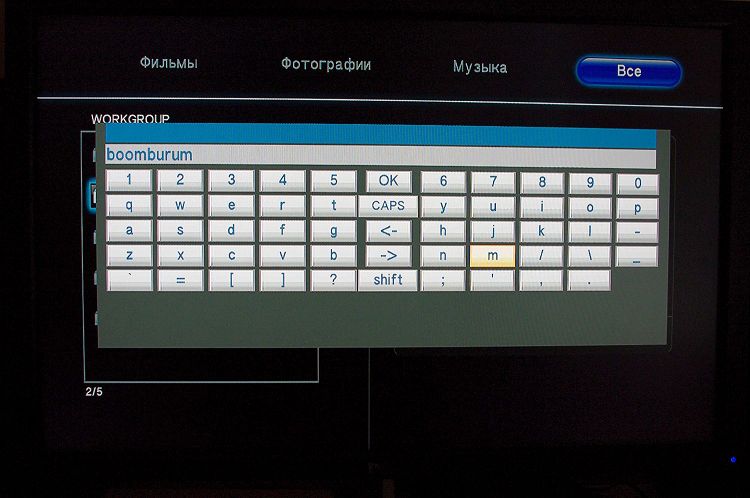
Honestly, I already lost the habit of such an input method, but in the dark I really appreciated it - I did it very quickly, without looking at the buttons of the console. He would have the backlight, and so ... But I was surprised that the console from the Microlab Solo 6C speakers came up to the player - I just in case wanted to turn down the volume, and eventually got to navigate the player menu)
Web preview works even for large files. There are no problems with Cyrillic, but omnivorous about a little further.
 Copying
Copying
It's simple. The screen is divided into two parts - on the left, what and where to copy is selected, on the right - where. Select the necessary files and the "destination" - the whole process will be accompanied by an informative progress bar.
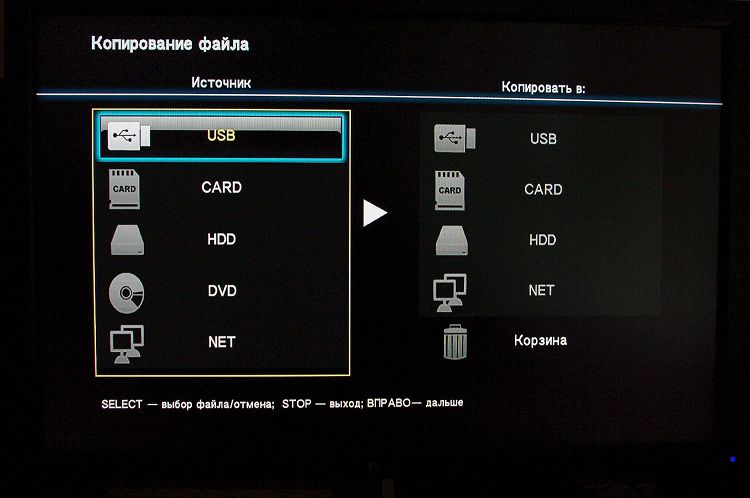
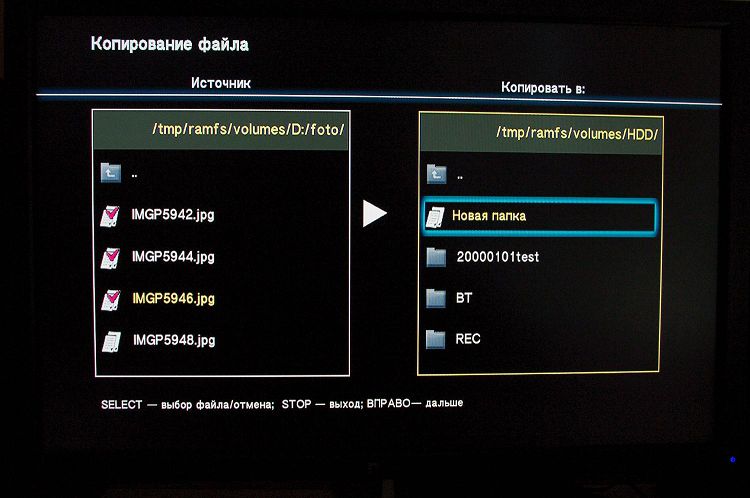
In principle, this item could be embedded in the "View", then the main menu of the device would look even simpler.
 Settings
Settings
Similar tabs at the top of the screen:
"DNR-filter" - in (s) includes automatic noise reduction
"Encoding" - not only for files, but also for subtitles (there is Cyrillic and UTF8 / 16)
Wireless setup . Many are often interested in the question (regarding detailed devices): “ Is there Wi-Fi there and if not, can the device be made to work through an external model? ".
The player offers three connectivity options - Infrastructure (AP), Point-to-Point (Ad Hoc), and WPS (AP). But there is no wireless module inside) Its presence is assumed by the user - for this case I used the D-Link DWA-140 adapter, but I couldn’t make it work (although I used it quite tolerably on the same Dune Base 3). The manufacturer recommends using USB devices on RTL 8187B, 8191 and 8192 chips, but I don’t have such wealth, so I had to without Wi-Fi.

Well, here's what I want to pay attention to. The process of updating the firmware is done through ... In general, updating the firmware through the settings window did not work for me and, apparently, does not work for others either) And you have to do this: go to the manufacturer’s website, download the necessary files, drop them on the USB flash drive and already only after that we do our plans. At least, this is how it is proposed to install the BT client and samba, whose files are on the miniCD out of the box and which need to be copied from there to the USB flash drive. To my shame, I don’t have a drive on one of the three home computers (there is one on one, but it’s slotted, so I dig out more with pulling out the pig), which is why I was left without a part of the device’s functionality (if you believe the forum IXBT, the inside is quite tolerable rocking). At a minimum, this approach is inconvenient, as a maximum - at the moment I have not found a single file on the company's website. But it would seem ...
As an option, go over HTTP to the IP player - there will be a simple web interface (Neighbor Web) with a primitive torrent client (btpd) ... but this should be entered through the computer’s browser. So something incomprehensible happened :)
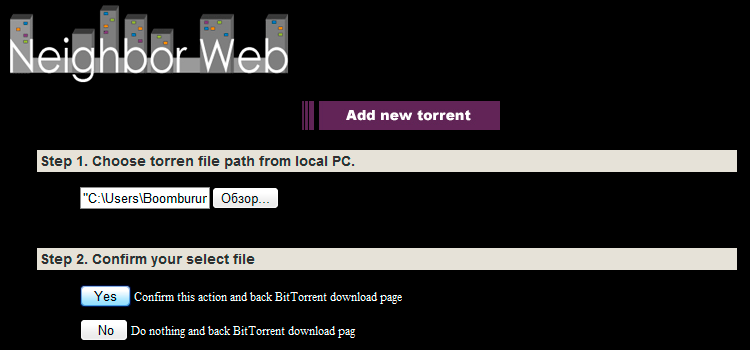


It all started with playing the blurred image of the film “Little Big Soldier” with old Jackie, which was shown on the network - without any problems, the film began to play. When the file was selected, the message “Network speed 30,000 kbps” jumped out - in the future this figure fluctuated in the range of 25-30K.
The player remembers the place where the playback of the file ended and knows how to continue playing from the stop. If desired, there is a rewind (1.5x, 2x, 4x, 8x, 16x and 32x - even at the maximum speed, the rewind remains smooth) and slow playback (3 / 4x, 1 / 2x, 1 / 4x, 1 / 8x and 1 / 16x ). Zoom available - 2x, 3x, 4x or 8x.
Subtitles are turned on by a separate button and are quite flexibly configured - encoding, color, size, indent, and synchronization; It's great that all this changes while watching, and not through the exit to the settings menu.
To test the omnivorousness of the media player, I took the standard test kit HDTV Test 1.7 , to which I added a couple of large photos and music files. The results are as follows:
1 - Total bitrate with sound
There were no problems in the folder with subtitles - everything that was was working.
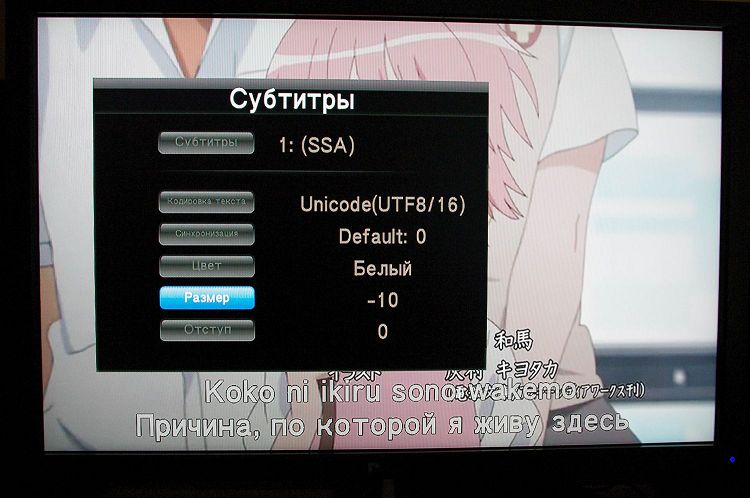
Photos (JPG, 46723104) were shown without problems, turned and approached - all without delay. There was no problem with music either, but this function is inconvenient - no special tools, just opening files “one by one”.
At the request of the workers, I will try to lay out the information on the Linux systems that are installed in the devices I test) I only managed to access this media player via telnet, which issued the following:
/ # uname -a
/ # free
/ # cat / proc / cpuinfo
/ # cat / proc / meminfo
/ # df -h
 Good design
Good design
 Very quiet work
Very quiet work
 All-metal body
All-metal body
 Various connectors - 2 USB, miniUSB, eSATA, HDMI, card reader
Various connectors - 2 USB, miniUSB, eSATA, HDMI, card reader
 Remote control buttons are duplicated on the front panel.
Remote control buttons are duplicated on the front panel.
 Convenient and practical remote
Convenient and practical remote
 Quick work, omnivorous
Quick work, omnivorous
 Price
Price
 Wi-Fi not initially
Wi-Fi not initially
 No patchcords and HDMI cables included
No patchcords and HDMI cables included
 Inconvenient firmware upgrade process
Inconvenient firmware upgrade process
 Very modest functionality, there is almost nothing except viewing content
Very modest functionality, there is almost nothing except viewing content
 Not yet supported: drives over 1TB, memory cards over 4GB, flash drives over 16GB
Not yet supported: drives over 1TB, memory cards over 4GB, flash drives over 16GB
 The printed circuit board is very hot (but if it works, then everything goes according to plan)
The printed circuit board is very hot (but if it works, then everything goes according to plan)
 Screws (from the kit) for fastening the disk touch the board elements
Screws (from the kit) for fastening the disk touch the board elements
The price of this device starts from 3900 rubles per box without a disk. Very affordable.
To be honest, I didn’t understand at all why BBK has released three new players, a review of the most adult of which you just read :) After all, there are already a few popcorn that work well and also sell well. And here, in fact, even in the top model there is absolutely nothing revolutionary new, not to mention the younger models. There is no Mediabar, on which the company placed such a big emphasis - and in fact it was so desirable to touch.
But, in fact, consumers have only benefited from this. The price of all three new products is more than democratic, which means that the cost of previous models may be further reduced. But for this money a player is offered, the capabilities of which will be enough for most fans to watch even the highest quality films) Excellent omnivorousness both in file formats and supported media - the plastic O! Play or some other foreign Chinese box can hardly boast. Practical metal body - another plus for aesthetes.
Of course, it wasn’t enough in this keg of honey and without tar - what is the interface alone ... IMHO, it should be at least a little embarrassing for the public in our time) But on the other hand ... who is looking at these interfaces? Moving through folders in search of a movie will take a fraction of a percent of the time that the movie goes.
In general, a very good choice for your money - the price / quality ratio is at a more than competitive level. To be or not to be - here you need to solve the tasks that you want to delegate to this kind of device.
As you might guess from the photos, the hero of the next review will be the new iPod Nano 6G. Cool thing;)
Successes!

Not so long ago, these devices began to appear on store shelves, so I decided to acquaint you with what the company released this time.
As in glossy magazines, it would be possible to tighten a long song about the fact that the Internet is entering our life more and more and how great it is to watch the right movie with your friends without a computer ... but I hope that such a class of devices like HD media players do not need to be introduced therefore, I propose to proceed immediately to the body. I decided to take the most "adult" model, namely, BBK MP070S .
')
Specs
Embedded HDD Type : 3.5 "SATA HDD
Video Output : Composite, Component, HDMI 1.3
Resolution : 480p, 576p, 720p, 1080i / p (24/50 / 60Hz)
Audio output : Stereo RCA, Coaxial, Optical SPDIF
Connectors : 2xUSB, miniUSB, eSATA
Card reader : SD, MMC, MS
Network : RJ-45 Ethernet; 802.11n optional
Services : BitTorrent Client
Decoders : DTS, AC3
Supported codecs
Video : DivX, XVID SD / HD, MPEG-1/2/4 / 4.2, WMV9 (MP @ HL), H.264, VC-1, AVC (HD)
Audio : AC3 (Dolby Digital), DTS, WMA, WMA Pro, AAC, MP1, MP2, LPCM
Supported Formats
Video : MPEG-1/2/4, MPEG-1/2 PS (M2P, MPG), MPEG-2, VOB, AVI, ASF, WMV, MKV (Matroska), MOV (H.264), MP4
Audio : AAC, M4A, MPEG audio (MP1, MP2, MPA), WAV, WMA
Subtitles : SRT, SMI, SUB, SSA
Photo : JPEG HD, JPEG, BMP, PNG
Other : ISO, IFO
Dimensions : 162x210x51.5mm
Weight : 0.88kg
Equipment
The box is quite small and light - the lion's share of the space inside is occupied by a porous material, in the thick of which the media player was hidden. Additionally, the device was wrapped in an air bubble film (pi-pi-pi)

So, included:
- HD-media player BBK MP070S
- Operation manual + warranty card
- Wires for connecting an external SATA disk
- Hex L-key
- Wire 3xRCA-3xRCA
- Audiovideo cable
- Network adapter
- miniCD disk
- 4 screws
- Remote controller
| Bubble packaging is a flexible transparent plastic material whose surface is evenly covered with small projections filled with air. Used for packaging fragile items. It was invented by two engineers: Alfred Fielding and Mark Chavann in 1957. Initially bubble wrap was conceived as a new material for wallpaper, which would be easy and convenient to clean. |
Appearance
The media player is compact enough - a little more than ASUS O! Play , but significantly less than previous models, much less such combines as Dune Base . Low weight, which means that the disk has yet to be put - perhaps it will fit inside it.
The body is entirely made of ferrous metal, but its texture in different places is different. For example, the top cover is semi-gloss, the front side has a fine polishing texture, and the side “edges” are pleasantly rough. Why such a platter is not clear, but on the whole it looks very solid - if it were not for the BBK sign on the front side, then no one would have guessed anything)

On the front side, there are many unusual things - a handful of buttons duplicated from the console and uncovered connectors (2xUSB, miniUSB and a card reader for SD / MMC / MS) create the basic “hype” - on the one hand, this “scatter” really scares ... but with on the other hand, this is practical, since the user of devices will not have to go anywhere to connect, and it will be possible to control the process without a remote control.

On the reverse side is another “assorted” - a whole scattering of various connectors. Ethernet, HDMI (1.3), component and composite video outputs, stereo output, digital optical and coaxial audio output ... There is even eSATA for connecting an external drive - in general, a good arsenal! Instead of the usual power cord (C13), you will have to use a network adapter, since the device cannot be more than 12V. Power consumption - less than 16W.

| C13 / C14 - a three-pass plug pair (plug-socket) for 10 Amps to connect electrical equipment to the mains. Used in computing, electrical appliances and communication technology. |

On the bottom side there are 4 stylish metal legs with rubber inserts.


After carefully examining the case (in search of warranty seals and screws to disassemble the case), I came to the conclusion that no covers are simply removed — you have to unwind the case to install a disk; However, the hex key in the kit is not just put. This is all written in the instructions ... but inquisitive minds do not read them;)

I was hoping that everything would be limited to 4 cogs on the front side, but as it turned out, they hold only the front part of the case - a neat all-metal plate with holes. Literally in an instant, I was crawling under the table in search of decorative nozzles that had flown down from all the buttons - they are not fixed at all, so be careful when disassembling (or rather drop a drop of superglue on each button).


The board did not pull out, although most of it was already visible. I had to unscrew 2 more screws on the back side - only then was happiness. Yeah, the path is not easy - in most cases you have to unscrew no more than 2-4 cogs ... or even insert the disc into the retractable slide.

Very, very liked the remote! From which side you do not look at it, it is rather small and light, but all this is not at the expense of the convenience of holding in your hand. Slightly rough plastic (quality) conveniently located buttons - Power at the very top will definitely be in the dark; The “circle” for moving around the menu is clearly highlighted and can be used without moving the remote in your hand; track control buttons, volume buttons - you will not confuse them with anything either. Everything is great - the only drawback is that there is no backlight - in the dark in the "small" buttons will not understand (well, or have to memorize everything). Food - one lithium CR2025 battery on 3B (140 mAh).

Insides
If you look at the top, most of the printed circuit board takes up space for the hard disk - it is supposed to join it to the corresponding connector and tighten the bottom 4 screws from the kit. At this stage there is an unpleasant trifle - the complete screws have a very large cap, with which they touch a part of the board connectors; The easiest way is to use "your" screws, but if someone does not have them, you will have to search. Or work with a file;)

Next to the disc area is a sticker with hieroglyphs, where only “1Tb” is understandable - apparently, this is a restriction on the volume of 1Tb; it is also confirmed in the manual - as long as the manufacturer promises correct work only with disks up to 1TB (as well as with cards up to 4GB and flash drives up to 16GB).

I only had disks for 500 and 1000GB - everything worked without problems. Although ... I tried the existing 32GB flash drive for the sake of interest - the player fell into a stupor until the flash drive was removed. All tests were conducted on a 500-gigabyte Seagate ST3500830SCE DB35.3 .

There is nothing more interesting on this side of the board - soldered buttons, diodes and connectors. Much "meat" on the reverse side. Ten two konderov, NAND- shemku Hynix HY27UF082G2B (controller AU6986 ) and a kind of indefatigable Mega 1008NE MPTU1G16DG-AC .


There are two more “prepared” places where nothing is unsoldered - perhaps something will appear in the next versions of the device, if they are on the same board.

The most "tasty" ( Realtek RTD1073DD ) is under a small cooler - I did not take it off, as it seems to be on hot melt, which I simply do not have.

At first, the device worked on the table (or rather, on the packing “foam”) in a disassembled form - the main thing is that the cooler does not cling to anything. It is impossible without it - in idle mode, even on the reverse side of the board it becomes very hot. In this situation, there is a small hum (“cooler + hard disk” at a distance of 50 cm from the ears), but if you put everything in the case and sit a couple of meters away from the TV, you can ignore the noise.

Turn on and work
The manual says that the remote control must be carefully aimed at the IR receiver, but my signals were received even at an angle of 90 degrees. After pressing the "red button", the device turns on and comes on full alert for a modest 15 seconds.
First, there is a primary configuration - language (9 languages available, including Russian) menu, date and time, task of wired network parameters (I trusted DHCP, although everything can be driven in manually; I liked how the fields for entering IPs look like). Then follows the offer to format the installed disk.
By the way, the most primitive interface was to be observed further, to which I was somewhat surprised. Why did the company develop the “sensational” mediabar shell if it is not here? But I was hoping to see) Moreover, even in previous models of popcorn, the interface was much more advanced and functional. Here ... something completely incomprehensible from the past. But, we have to admit, IT does not slow down at all and, in principle, performs all the tasks well;)
So, the main screen consists of only 3 items - “ View ”, “ Settings ” and “ Copy ”.

Due to the fact that in each of the paragraphs there is not so much of everything, I will delve a little into intimate details. I really wanted to make beautiful screenshots, but even with the PIP mode via the component connection, the image could not be captured (and there was no capture card) - so everything was taken with a tripod.

 View
ViewAt the very top of this window there are 4 tabs of “media filters” - “movies”, “photos”, “music” and “all”; This is not a new approach, but as practice shows, it is very convenient.


Below is selected the data source - USB-drive, HDD, DVD, NET or memory card. It is strange that all this is present, although some of the carriers are simply not in the system.
Moving through folders is fast, as well as flipping through the file list. Each file to the right of the name displays information about it, and in the case of media data, the contents are also shown in the preview window. It is inconvenient that there is no scrollbar in the file selection window.
If you try to create a new folder somewhere, the on-screen keyboard will appear on the screen; you will have to print on it if you want to log in through the player to any computer on the network.

Honestly, I already lost the habit of such an input method, but in the dark I really appreciated it - I did it very quickly, without looking at the buttons of the console. He would have the backlight, and so ... But I was surprised that the console from the Microlab Solo 6C speakers came up to the player - I just in case wanted to turn down the volume, and eventually got to navigate the player menu)
Web preview works even for large files. There are no problems with Cyrillic, but omnivorous about a little further.
 Copying
CopyingIt's simple. The screen is divided into two parts - on the left, what and where to copy is selected, on the right - where. Select the necessary files and the "destination" - the whole process will be accompanied by an informative progress bar.


In principle, this item could be embedded in the "View", then the main menu of the device would look even simpler.
 Settings
SettingsSimilar tabs at the top of the screen:
"DNR-filter" - in (s) includes automatic noise reduction
"Encoding" - not only for files, but also for subtitles (there is Cyrillic and UTF8 / 16)
Wireless setup . Many are often interested in the question (regarding detailed devices): “ Is there Wi-Fi there and if not, can the device be made to work through an external model? ".
The player offers three connectivity options - Infrastructure (AP), Point-to-Point (Ad Hoc), and WPS (AP). But there is no wireless module inside) Its presence is assumed by the user - for this case I used the D-Link DWA-140 adapter, but I couldn’t make it work (although I used it quite tolerably on the same Dune Base 3). The manufacturer recommends using USB devices on RTL 8187B, 8191 and 8192 chips, but I don’t have such wealth, so I had to without Wi-Fi.

Well, here's what I want to pay attention to. The process of updating the firmware is done through ... In general, updating the firmware through the settings window did not work for me and, apparently, does not work for others either) And you have to do this: go to the manufacturer’s website, download the necessary files, drop them on the USB flash drive and already only after that we do our plans. At least, this is how it is proposed to install the BT client and samba, whose files are on the miniCD out of the box and which need to be copied from there to the USB flash drive. To my shame, I don’t have a drive on one of the three home computers (there is one on one, but it’s slotted, so I dig out more with pulling out the pig), which is why I was left without a part of the device’s functionality (if you believe the forum IXBT, the inside is quite tolerable rocking). At a minimum, this approach is inconvenient, as a maximum - at the moment I have not found a single file on the company's website. But it would seem ...
As an option, go over HTTP to the IP player - there will be a simple web interface (Neighbor Web) with a primitive torrent client (btpd) ... but this should be entered through the computer’s browser. So something incomprehensible happened :)



Reproduction
It all started with playing the blurred image of the film “Little Big Soldier” with old Jackie, which was shown on the network - without any problems, the film began to play. When the file was selected, the message “Network speed 30,000 kbps” jumped out - in the future this figure fluctuated in the range of 25-30K.
The player remembers the place where the playback of the file ended and knows how to continue playing from the stop. If desired, there is a rewind (1.5x, 2x, 4x, 8x, 16x and 32x - even at the maximum speed, the rewind remains smooth) and slow playback (3 / 4x, 1 / 2x, 1 / 4x, 1 / 8x and 1 / 16x ). Zoom available - 2x, 3x, 4x or 8x.
Subtitles are turned on by a separate button and are quite flexibly configured - encoding, color, size, indent, and synchronization; It's great that all this changes while watching, and not through the exit to the settings menu.
To test the omnivorousness of the media player, I took the standard test kit HDTV Test 1.7 , to which I added a couple of large photos and music files. The results are as follows:
| File name | Resolution | Overall bit rate 1 | Result |
| 00019.m2ts | 1920x1080 | 47.2 Mbps |  / The file opens, plays a second and the player throws it into the file manager. / The file opens, plays a second and the player throws it into the file manager. |
| 03.split.5.ts | 1920x1080 | 35.2 Mbps |  |
| 720p16rf-001.mkv | 1280x720 | 1 990 Kbps |  |
| Avalon.split.34.m2ts | 1920x1080 | 37.6 Mbps |  / “Unknown audio format” message is displayed, but video is / “Unknown audio format” message is displayed, but video is |
| Casino.21.mkv | 1920x800 | 15.0 Mbps |  |
| Casino.32.mkv | 1920x800 | 20.5 Mbps |  |
| Casino.42.mkv | 1920x800 | 30.3 Mbps |  |
| Casino.50.m2ts | 1920x800 | 37.9 Mbps |  |
| Casino.50.mkv | 1920x800 | 39.8 Mbps |  / At the very beginning a small short delay of personnel / At the very beginning a small short delay of personnel |
| Casino.Royale.BDrip.1080p.SPLIT-004.mkv | 1920x800 | 25.6 Mbps |  |
| Deinterlace.m2ts | 1449x1080 | 13.3 Mbps |  |
| H264_TrueHD.m2ts | 1920x1080 | 38.6 Mbps |  / “Unknown audio format” message is displayed, but video is / “Unknown audio format” message is displayed, but video is |
| hns-fc-new-002.mkv | 1920x1080 | 5 586 Kbps |  / Video goes without brakes, but artifacts appear on it / Video goes without brakes, but artifacts appear on it |
| ovescan_geometry.mkv | 1920x1080 | 292 Kbps |  :) :) |
| Satoyama.II.Japan.Secret.Water.Garden .1080p.rus.-002.mkv | 1920x1072 | 13.3 Mbps |  |
| TheBankJob-sample-16rf.mkv | 1920x1080 | 11.6 Mbps |  / Video goes without brakes, but artifacts appear on it / Video goes without brakes, but artifacts appear on it |
| Transporter 3.2008.BD.Remux. 1080p.h264.Rus.Eng.Commentary-002.mkv | 1920x1080 | 23.8 Mbps |  |
| twin.peaks.s01e01.sample-007.mkv | 720x572 | 2 728 Kbps |  |
| VC-1_Sub.mkv | 1920x1080 | 19.0 Mbps |  / Subtitles have / Subtitles have |
There were no problems in the folder with subtitles - everything that was was working.

Photos (JPG, 46723104) were shown without problems, turned and approached - all without delay. There was no problem with music either, but this function is inconvenient - no special tools, just opening files “one by one”.
Quite inside
At the request of the workers, I will try to lay out the information on the Linux systems that are installed in the devices I test) I only managed to access this media player via telnet, which issued the following:
BusyBox v1.1.3 (2010.01.04-09:16+0000) Built-in shell (ash)
Enter 'help' for a list of built-in commands./ # uname -a
Linux Venus 2.6.12.6-VENUS #5 Mon Jan 4 17:14:52 CST 2010 mips unknown/ # free
total used free shared buffers Mem: 120188 89504 30684 0 136 Swap: 32 0 32 Total: 120220 89504 30716
/ # cat / proc / cpuinfo
system type: Realtek Venus processor: 0 cpu model: MIPS 24K V7.8 BogoMIPS: 269.51 wait instruction: yes microsecond timers: yes tlb_entries: 32 extra interrupt vector: yes hardware watchpoint: yes ASEs implemented: mips16 VCED exceptions: not available VCEI exceptions: not available
/ # cat / proc / meminfo
MemTotal: 120188 kB MemFree: 30672 kB Buffers: 148 kB Cached: 8484 kB SwapCached: 0 kB Active: 9060 kB Inactive: 2780 kB HighTotal: 0 kB HighFree: 0 kB LowTotal: 120188 kB LowFree: 30672 kB SwapTotal: 32 kB SwapFree: 32 kB Dirty: 0 kB Writeback: 0 kB Mapped: 9460 kB Slab: 6456 kB CommitLimit: 60124 kB Committed_AS: 10184 kB PageTables: 440 kB VmallocTotal: 1048548 kB VmallocUsed: 1124 kB VmallocChunk: 1046972 kB
/ # df -h
Filesystem Size Used Available Use% Mounted on / dev / root 99.9M 99.9M 0 100% / / dev / mtdblock / 2 40.0M 1.3M 38.7M 3% / usr / local / etc / dev / rd / 0 40.0k 40.0k 0 100% / mnt / rd / dev / scsi / host0 / bus0 / target0 / lun0 / part1 465.3G 1.8G 463.5G 0% / tmp / hdd / volumes / HDD1 / dev / scsi / host0 / bus0 / target0 / lun0 / part3 151.9M 11.6M 132.5M 8% / tmp / hdd / root //192.168.1.5/C$ 200.1G 105.5G 94.6G 53% / tmp / netb / mnt / My_Shortcuts / 123: 456 / X $ / #
| I understand almost nothing in Linux, but when you ask for this information - I try to get it) Thanks to those who helped. And further. My reviews do not pretend to be complete and professional, but I find it interesting and I try - if you have ideas for improving / changing the reviews or suggestions on the topics of the reviews - do not hesitate to write) |
 Advantages and disadvantages
Advantages and disadvantages
 Good design
Good design Very quiet work
Very quiet work All-metal body
All-metal body Various connectors - 2 USB, miniUSB, eSATA, HDMI, card reader
Various connectors - 2 USB, miniUSB, eSATA, HDMI, card reader Remote control buttons are duplicated on the front panel.
Remote control buttons are duplicated on the front panel. Convenient and practical remote
Convenient and practical remote Quick work, omnivorous
Quick work, omnivorous Price
Price Wi-Fi not initially
Wi-Fi not initially No patchcords and HDMI cables included
No patchcords and HDMI cables included Inconvenient firmware upgrade process
Inconvenient firmware upgrade process Very modest functionality, there is almost nothing except viewing content
Very modest functionality, there is almost nothing except viewing content Not yet supported: drives over 1TB, memory cards over 4GB, flash drives over 16GB
Not yet supported: drives over 1TB, memory cards over 4GB, flash drives over 16GB The printed circuit board is very hot (but if it works, then everything goes according to plan)
The printed circuit board is very hot (but if it works, then everything goes according to plan) Screws (from the kit) for fastening the disk touch the board elements
Screws (from the kit) for fastening the disk touch the board elementsThe price of this device starts from 3900 rubles per box without a disk. Very affordable.
The end
To be honest, I didn’t understand at all why BBK has released three new players, a review of the most adult of which you just read :) After all, there are already a few popcorn that work well and also sell well. And here, in fact, even in the top model there is absolutely nothing revolutionary new, not to mention the younger models. There is no Mediabar, on which the company placed such a big emphasis - and in fact it was so desirable to touch.
But, in fact, consumers have only benefited from this. The price of all three new products is more than democratic, which means that the cost of previous models may be further reduced. But for this money a player is offered, the capabilities of which will be enough for most fans to watch even the highest quality films) Excellent omnivorousness both in file formats and supported media - the plastic O! Play or some other foreign Chinese box can hardly boast. Practical metal body - another plus for aesthetes.
Of course, it wasn’t enough in this keg of honey and without tar - what is the interface alone ... IMHO, it should be at least a little embarrassing for the public in our time) But on the other hand ... who is looking at these interfaces? Moving through folders in search of a movie will take a fraction of a percent of the time that the movie goes.
In general, a very good choice for your money - the price / quality ratio is at a more than competitive level. To be or not to be - here you need to solve the tasks that you want to delegate to this kind of device.
As you might guess from the photos, the hero of the next review will be the new iPod Nano 6G. Cool thing;)
Successes!
Source: https://habr.com/ru/post/107749/
All Articles
